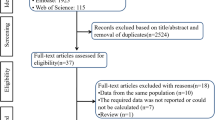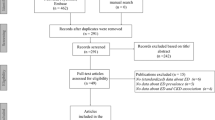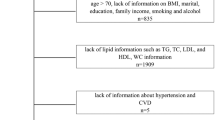Abstract
The association between erectile dysfunction (ED) and acute myocardial infarction (AMI) among men was examined in the Integrated Healthcare Information Services National Managed Care Benchmark Database (IHCIS). The IHCIS is a fully de-identified, HIPAA-compliant database and includes complete medical history for more than 17 million managed care lives; data from more than 30 US health plans, covering seven census regions; and patient demographics, including morbidity, age and gender. A total of 12 825 ED patients and an equal number of male patients without ED were included in the retrospective cohort study. Logistic regression analyses were performed to assess the adjusted risk of AMI that accounted for age at ED diagnosis, smoking, obesity and medications including ACE inhibitors, beta blockers and statins. The cohort of men with ED were observed to have a two-fold increase in the risk for AMI (OR=1.99, 95% CI=1.17, 3.38) after adjusting for age at ED diagnosis, smoking, obesity, and use of ACE inhibitors, beta blockers and statins. Some evidence of a possible trend toward increased risk was detected by age group. After controlling for the aforementioned covariates and compared to men 30–39 y of age, it was noted that patients 40–44 y of age were 3.8 times more likely to develop an AMI (OR=3.76, 95% CI=1.21, 11.7), 45- to 49-y-old men were also more than three times as likely to have an AMI (OR=3.14, 95% CI=1.03, 9.64), and 50- to 55-y-old patients had a four-fold increased risk of developing AMI (OR=4.04, 95% CI=1.39, 11.7). The risk becomes more pronounced with increasing age, indicating the need for cardiologists and internists to monitor ED patients who may not necessarily present with cardiovascular symptoms.
This is a preview of subscription content, access via your institution
Access options
Subscribe to this journal
Receive 8 print issues and online access
$259.00 per year
only $32.38 per issue
Buy this article
- Purchase on Springer Link
- Instant access to full article PDF
Prices may be subject to local taxes which are calculated during checkout
Similar content being viewed by others
References
Benet AE, Melman A . The epidemiology of erectile dysfunction. Urol Clin N Am 1995; 22: 699–709.
Bartolotti A, Parazzini F, Colli E, Landoni M . The epidemiology of erectile dysfunction and its risk factors. Int J Androl 1997; 20: 323–334.
Khan MA et al. Second Consensus Conference on Cardiovascular Risk Factors and Erectile Dysfunction. Curr Med Res Opin 2002; 18: 33–35.
O'Kane PD, Jackson G . Erectile dysfunction: is there silent obstructive coronary artery disease? Int J Clin Pract 2001; 55: 219–220.
Solomon H, Man JW, Jackson G . Erectile dysfunction and the cardiovascular patient: endothelial dysfunction is the common denominator. Heart 2003; 89: 251–253.
Jackson G . Erectile dysfunction and cardiovascular disease. Int J Clin Pract 1999; 53: 363–368.
Kirby M, Jackson G, Betteridge J, Friedli K . Is erectile dysfunction a marker for cardiovascular disease? Int J Clin Pract 2001; 55: 614–618.
Solomon H et al. Erectile dysfunction: cardiovascular risk and the role of the cardiologist. Int J Clin Pract 2003; 57: 96–99.
Sullivan ME, Keoghane SR, Miller MA . Vascular risk factors and erectile dysfunction. BJU Int 2001; 87: 838–845.
Virag R, Bouilly P, Frydman D . Is impotence an arterial disorder? A study of arterial risk factors in 440 impotent men. Lancet 1985; 1: 181–184.
Feldman HA et al. Erectile dysfunction and coronary risk factors: prospective results from the Massachusetts Male Aging Study. Prev Med 2000; 30: 328–338.
Feldman HA et al. Impotence and its medical and psychosocial correlates: results of the Massachusetts Male Aging Study. J Urol 1994; 151: 54–61.
Sullivan ME et al. Nitric oxide and penile erection: is erectile dysfunction another manifestation of vascular disease? Cardiovasc Res 1999; 43: 658–665.
Muller SC, el-Damanhoury H, Ruth J, Lue TF . Hypertension and impotence. Eur Urol 1991; 19: 29–34.
Burchardt M et al. Erectile dysfunction is a marker for cardiovascular complications and psychological functioning in men with hypertension. Int J Impot Res 2001; 13: 276–281.
Burchardt M et al. Hypertension is associated with severe erectile dysfunction. J Urol 2000; 164: 1188–1191.
Greenstein A et al. Does severity of ischemic coronary disease correlate with erectile function? Int J Impot Res 1997; 9: 123–126.
Wei M et al. Total cholesterol and high density lipoprotein cholesterol as important predictors of erectile dysfunction. Am J Epidemiol 1994; 140: 930–937.
Murray CJL, Lopez AD . Alternative projections of mortality and disability by cause 1990–2020: Global Burden of Disease Study. Lancet 1997; 349: 1498–1504.
American Heart Association. 2003 Heart and Stroke Statistical Update. American Heart Association: Dallas, TX, 2002.
Probstfield JL . How cost-effective are new preventive strategies for cardiovascular disease? Am J Cardiol 2003; 91: 22G–27G.
Author information
Authors and Affiliations
Corresponding author
Rights and permissions
About this article
Cite this article
Blumentals, W., Gomez-Caminero, A., Joo, S. et al. Should erectile dysfunction be considered as a marker for acute myocardial infarction? Results from a retrospective cohort study. Int J Impot Res 16, 350–353 (2004). https://doi.org/10.1038/sj.ijir.3901174
Received:
Revised:
Accepted:
Published:
Issue Date:
DOI: https://doi.org/10.1038/sj.ijir.3901174
This article is cited by
-
Interactions between erectile dysfunction, cardiovascular disease and cardiovascular drugs
Nature Reviews Cardiology (2022)
-
Erectile Dysfunction: an Early Sign of Cardiovascular Disease
Current Cardiovascular Risk Reports (2015)
-
Association between metabolic syndrome and sexual dysfunction among men with clinically diagnosed diabetes
Diabetology & Metabolic Syndrome (2013)
-
Improvement of erectile function by Korean red ginseng (Panax ginseng) in a male rat model of metabolic syndrome
Asian Journal of Andrology (2013)



